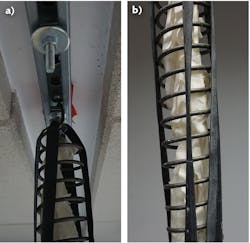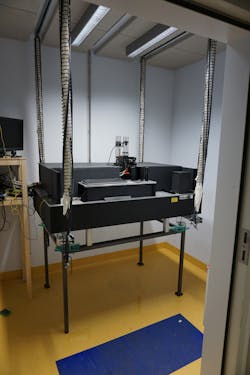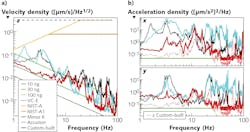Vibration Isolation: Homemade low-frequency vibration isolation system matches or exceeds commercial options
MAYANK CHUGH and GERO HERMSDORF
Whether part of our daily lives due to moving machinery or building heating/cooling systems or in the more remarkable case of seismic activity during earthquakes, mechanical vibrations are pervasive. Within a building, mechanical vibrations can range between one and several-hundred Hertz and arise from a variety of sources—movement of people (1–5 Hz), equipment lifts (≤40 Hz), and a host of other disturbances such as heavy doors, machines, ventilation or air-conditioning systems, transformers, wind and ocean waves, and nearby modes of transport including cars, trains, or planes (7–350 Hz).1
For long-wavelength vibrations with frequencies below 100 Hz, such vibrations are often inadequately damped in ordinary laboratory buildings. Therefore, operation of high-precision instruments across different fields such as metrology, nanofabrication, medical systems, and microscopy require vibration isolation to allow interference-free measurements.
At the University of Tübingen’s Center for Plant Molecular Biology (ZMBP), the focus is on optical tables for microscopy applications. A vibration isolation system for an optical table must damp mechanical vibrations before they interfere with the critical characterization of nanoscale objects under measurement. For nanoscale microscopy and single-molecule imaging, sufficient vibration isolation of the optical tables is a must for reproducible, accurate, and high-resolution measurements.
Although common vibration isolation systems include air-damped tables, bungee cords, pendulum systems, passive systems, and active systems with feedback circuits, many commercial options are expensive and operate poorly in the low-frequency range.2-7 In terms of affordability, bungee cords are the best option—however, the rubber used as its constituent component makes it unreliable over long time periods due to a material property called creep.
Recently, our laboratory developed and characterized a custom-built vibration isolation system using relatively simple and low-cost mechanical components that meets—and in some aspects exceeds—commercially available systems for low-frequency damping.
Applying vibration-isolation principles
The custom-built isolation system is a steel spring suspension system operated in a standard ceiling height (2.5 m) format. In other words, it is a Hookean spring system further damped with silicone oil.
Usually, in a Hookean spring suspension system from the ceiling, the resonance frequency is primarily limited by the extensibility of the spring. Therefore, ceiling suspension setups using rubber bungee cords that are prone to creep—the aforementioned material property that allows permanent deformation owing to persistent mechanical stress—would require longer resting lengths and thus higher ceilings (approximately 4 m) for adequate damping.
To develop a high-performance vibration isolation system under standard ceiling heights that are unaltered by creep, we chose to work with steel springs. Steel springs serve as a fantastic alternative due to their shorter resting lengths and deflection resistance values—however, such a system requires a further damping arrangement. Steel springs in combination with high-viscosity silicone oil turned out to be the key ingredients in a recipe that dampens vibrations in all degrees of freedom.
Microscopy experiments at ZMBP are performed in the basement of a building in a room that is disconnected from the building itself using a steel plate over a vibration-damping foam. Built of brick walls over the steel plate and with a concrete ceiling, the room is supplemented with a soundproof door that creates acoustic isolation.
The home-built vibration isolation system was designed for a resonance frequency of 0.5 Hz. An optical table (900 × 1400 × 200 mm) is suspended from the ceiling using steel springs connected to mounting rails on the ceiling as well as on the optical table (see Fig. 1). The steel springs have a spring constant of 0.39 N/mm, initial tension of 21 N, unloaded resting length of 0.4 m, maximum extension of 1 m, and weight of 1.4 kg. Despite this stiffness, any possible high-frequency transmissions are minimized by squeezing rubber pads between the ends of the springs and the mounting rails.
To further damp the internal resonance of the steel springs and their surge, standard laboratory gloves made of latex were hung from the springs and tape was used to connect the spring coils. Alternatively, one can also use the inner tube of a bicycle tire. Long strips of the tube can be cut and mounted on the inner side of the springs. Together, such a system provides an affordable and efficient damping system.Real-world performance
To evaluate the performance of any vibration system, it is important to make sure it obeys common vibration criteria. Not only was the home-built vibration system evaluated against these criteria, its performance was compared to other common vibration isolation systems.
Generally, the vibration criteria are expressed as the square root of the mean vibration velocity (root-mean-squared, or rms), where the velocities are measured by the power spectral density of a vibration analyzer system on the optical table. In three walk-in chambers housed within the microscopy laboratory previously described, the rms velocity in the vertical direction was compared for three optical tables with different vibration-isolation systems to make sure all tables had comparable vibration inputs. Two tables were equipped with state-of-the-art active and passive vibration isolation systems, while the third one used the homemade damping system.
In the 1–10 Hz range, the custom-built system outperformed commercial systems from Minus K (Inglewood, CA) and Accurion (Göttingen, Germany). Above 10 Hz, the performance of all three systems was comparable (see Fig. 4).As with the other commercially available systems, the home-built vibration isolation station outperformed the strict NIST-A1 criterion. But all three systems underperformed using the VC-D vibration criterion. It is of course quite appropriate as VC-D is generally two-fold higher than VC-E and is the stringent standard requirement for scanning and transmission electron microscopes.
Since the damping element in the home-built system consists of steel spheres in highly viscous silicone oil, it was believed that the vibrations should be damped in all directions. To test this assumption, the setup was also subjected to horizontal measurements. Excitingly, the affordable setup outperformed the previously described commercial systems in the 1–100 Hz range.
At low frequencies and for non-vertical degrees of freedom, the steel spring viscous damping system is in fact better than state-of-the-art commercially available active and passive systems. Moreover, the damping in all directions is indicative of minimal coupling between the translational degrees of freedom (and most likely, for rotational degrees of freedom as well).
For any university laboratory, vibration isolation system cost is also a key consideration. The materials cost for the home-built system steel spheres, silicone oil, steel springs, and mechanical components is roughly €300. Including the optical table(~1500€) the home-built system cost roughly $1980 (€1800). In contrast, commercial setups from Minus K and Accurion are more than twice as expensive at roughly $5510 (€5000) and $9920 (€9000), excluding a optical table.
Application-specific tweaking
Scientists and engineers strive to make mechanical systems better in terms of performance and ability to handle numerous applications. While commercial active and passive vibration isolation systems are quite compact, aesthetically well-designed, and easily fit under an optical table, they oftentimes provide limited flexibility for manipulation.
Alternatively, the home-built system is significantly cheaper, easy to assemble, can be tuned for each application need, but must also rely on ceiling mounts and require adequate space for spring suspension that can interfere with certain application parameters.
Laboratories performing delicate measurements using superresolution microscopy and electron microscopy instruments just may be the appropriate audience for a home-built vibration isolation system. Tuning can be achieved (and isolation improved) through higher ceilings. For example, a ceiling height of 4 m should permit a resonance of approximately 0.3 Hz—much better than the current example with 2.5 m ceiling height and 0.5 Hz resonance frequency.
The viscous damping element can also be modulated by varying the size of the steel spheres and altering the viscosity of the silicone oil. Solely changing the suspension distance of the spheres into the glass beaker containing the silicone oil can vary the damping coefficient roughly tenfold.8 The setup is also easily scaled for different payloads.
For lower-frequency ranges and for certain translational and rotational degrees of freedom, a home-built vibration isolation system can outperform state-of-the-art commercial systems. Hopefully, the design methodology presented here will inspire others to develop home-built systems for application areas such as metrology and medicine.
REFERENCES
1. G. L. Hermsdorf et al., Rev. Sci. Instrum., 90, 1, 015113 (2019).
2. B. Voigtländer et al., Rev. Sci. Instrum., 88, 2, 023703 (2017).
3. See http://bit.ly/VibrationRef3.
4. M. Stephens, P. Saulson, and J. Kovalik, Rev. Sci. Instrum., 62, 4, 924–932 (1991).
5. D. L. Platus, “Negative-stiffness-mechanism vibration isolation systems,” Proc. SPIE, 1619, OPTCON ‘91, San Jose, CA (Feb. 1, 1992).
6. S. J. Richman et al., Rev. Sci. Instrum., 69, 6, 2531–2538 (1998).
7. M. Kim, H. Kim, and D. G. Gweon, Rev. Sci. Instrum., 83, 10, 105117 (2012).
8. E. Schäffer, S. F. Nørrelykke, and J. Howard, Langmuir, 23, 7, 3654–3665 (2007).
Mayank Chugh and Gero Hermsdorf are International Max Planck Research School PhD fellows in Cellular Nanoscience in the Center for Plant Molecular Biology (ZMBP) at the University of Tübingen, Tübingen, Germany; e-mails: [email protected] and [email protected]; https://uni-tuebingen.de.



